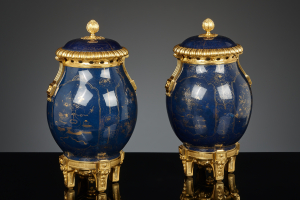French mounted Régence inkwell in the shape of a Chinese porcelain toad
French mounted Régence inkwell in the shape of a Chinese porcelain toad
A mounted inkwell consisting of a Chinese porcelain toad with a turquoise and aubergine glaze from the Kangxi period (1661-1722), fixed in French gilt bronze framework from the Régence period. The porcelain toad stands upon a cartouche-shaped base with ornaments in the shapes of shells, lizards, leaves and salamanders, as though the toad were in its natural habitat. Upon its back is a gilt bronzework piece with a lid, upon which the same ornaments are repeated. Below the lid is the holder for the glass inkwell. Flower-shaped appliques extend downwards from the inkwell along the toad’s flanks.
In China, the toad is seen as a symbol of longevity and wealth and was considered an auspicious omen. This turquoise toad was not born as an inkwell but as a brush rinser, a commonly used device by calligraphers in China. Such brushes were not used in Europe, however, since Europeans wrote using goose feathers. The practice of using metalwork to mount Far Eastern porcelain emerged in Europe in or before the late fourteenth century. Asian porcelain was seen as exotic and rare, and the application of silver, gilt silver and even gold metalwork – a practice also applied to other valuable objects made of semi-precious stones, rock crystal and porphyry, for example – was a sign of the lofty status held by Chinese porcelain. Using expensive materials to frame such objects reinforced the object’s value.
From a purely practical perspective, the addition of metal bracing also provided protection for the vulnerable porcelain. Around 1700, it became less standard for porcelain to be locked away in curiosity cabinets and began to be used to decorate entire rooms. More intimate and smaller rooms were not unheard of in eighteenth-century France; also, the import of Chinese porcelain became more accessible. The marchand-merciers of Paris therefore took full advantage of the fashion for mounted porcelain, among them Lazare Duvaux (1703-1758) and Thomas-Joachim Hebert (1687-1773), who supplied both the French nobility and the fashionable courts of France.
One of the most lucrative forms of this activity was the embellishment of Asian porcelain using gilt bronze, resulting in a type of object that became the vogue in Paris. The gilt bronze mountings allowed exotic porcelain pieces to be adapted to European aesthetic preferences, sometimes recasting the porcelain into a new role: bowls were transformed into potpourri pots, lidded pots became vases. On occasion, Asian porcelain was even combined with Meissen or Vincennes porcelain to create spectacular new objects, such as extravagant clocks. The marchand-merciers were generally responsible for the application of the gilt bronze mountings, which had to be tailored to each specific item. The craftsmen in the employ of these merchants, such as Jean-Claude Chambellan, better known as Duplessis (1695-1774), relied on inventiveness and virtuosity to produce the most desirable objects. The marchand-merciers themselves were often personally involved in the final design of the most important and unique pieces.
In France, early blue and white porcelain was initially the most popular product for mounting. Around the beginning of the eighteenth century, this preference began to change, and objects finished in celadon and other monochromes gradually became the most desirable mounting objects.
- Provenance
- Galerie J. Kugel, 1997
Private collection, Amsterdam - Period
- ca. 1725
- Material
- Chinese Kangxi porcelain, gilt bronze
- Dimensions
- 13.5 x 14.5 x 17.5 cm
Global shipping available










